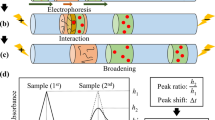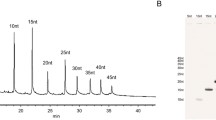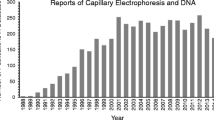Abstract
Myotonic dystrophy type 1 (DM1) is an autosomal dominantly inherited degenerative disease with a slow progression. At the present, there is no commercially available treatment, but sustained effort is currently undertaken for the development of a promising lead compound. In the present paper we report the development of a fast, versatile, and cost-effective affinity capillary electrophoresis (ACE) method for the screening and identification of potential drug candidates targeting pathological ARN probes relevant for DM1. The affinity studies were conducted in physiologically relevant conditions using 50 mM HEPES buffer (pH 7.4) in a fused silica capillary dynamically coated with poly(ethylene oxide), by testing a library of potential ligands against (CUG)50 RNA as target probe with a total run time of 4–5 h/ligand. For the most promising ligands, their affinity parameters were assessed and some results formerly reported on the affinity of pentamidine (PTMD) and neomycin against CUG repeats were confirmed. To the best of the authors’ knowledge, the estimated binding stoichiometry for some of the tested compounds (i.e., ~ 121:1 for PTMD against the tested RNA probe) is reported for the first time. Additionally, the potential of a novel pentamidine like compound, namely 1,2-ethane bis-1-amino-4-benzamidine (EBAB) with much lower in vivo toxicity than its parent compound has also been confirmed studying its effect on a live cell model by fluorescence microscopy. Further tests, such as the evaluation of the rescue in the mis-splicing of the involved genes, can be performed to corroborate the potential therapeutic value of EBAB in DM1 treatment.

ᅟ






Similar content being viewed by others
Change history
15 November 2018
Unfortunately the name of Jean Jacques Vanden Eynde was missing as co-author of this contribution. The correct list of authors is: Ioan O. Neaga, Stephanie Hambye, Ede Bodoki, Claudio Palmieri, Jean Jacques Vanden Eynde, Eugénie Ansseau, Alexandra Belayew, Radu Oprean, Bertrand Blankert.
15 November 2018
Unfortunately the name of Jean Jacques Vanden Eynde was missing as co-author of this contribution. The correct list of authors is: Ioan O. Neaga, Stephanie Hambye, Ede Bodoki, Claudio Palmieri, Jean Jacques Vanden Eynde, Eug?nie Ansseau, Alexandra Belayew, Radu Oprean, Bertrand Blankert.
15 November 2018
Unfortunately the name of Jean Jacques Vanden Eynde was missing as co-author of this contribution. The correct list of authors is: Ioan O. Neaga, Stephanie Hambye, Ede Bodoki, Claudio Palmieri, Jean Jacques Vanden Eynde, Eug��nie Ansseau, Alexandra Belayew, Radu Oprean, Bertrand Blankert.
References
Jameson JL. Principles of molecular medicine. Runge MS, Patterson C, editors. Totowa: Humana Press; 2006.
Servadio A, Poletti A, Servadio A, Taroni F. Triplet repeat diseases: from basic to clinical aspects. Brain Res Bull. 2001;56:159.
Machuca-Tzili L, Brook D, Hilton-Jones D. Clinical and molecular aspects of the myotonic dystrophies: a review. Muscle Nerve. 2005;32:1–18.
Schara U, Schoser BGH. Myotonic dystrophies type 1 and 2: a summary on current aspects. Semin Pediatr Neurol. 2006;13:71–9.
Ahmad SI. Neurodegenerative diseases. New-York : Landes Bioscience/ Springer Science+Business Media, LLC dual imprint / Springer series: Advances in Experimental Medicine and Biology. 2012.
Yotova V, Labuda D, Zietkiewicz E, Gehl D, Lovell A, Lefebvre J-F, et al. Anatomy of a founder effect: myotonic dystrophy in Northeastern Quebec. Hum Genet. 2005;117:177–87.
Turner C, Hilton-Jones D. The myotonic dystrophies: diagnosis and management. J Neurol Neurosurg Psychiatry. 2010;81:358–67.
Morgenlander JC, Massey JM. Myotonic dystrophy. Semin. Neurol. 1991.
Harley HG, Walsh KV, Rundle S, Brook JD, Sarfarazi M, Koch MC, et al. Localisation of the myotonic dystrophy locus to 19q13.2?19q13.3 and its relationship to twelve polymorphic loci on 19q. Hum Genet. 1991;87:73–80.
Brook JD, McCurrach ME, Harley HG, Buckler AJ, Church D, Aburatani H, et al. Molecular basis of myotonic dystrophy: expansion of a trinucleotide (CTG) repeat at the 3′ end of a transcript encoding a protein kinase family member. Cell. 1992;68:799–808.
Martorell L, Monckton DG, Sanchez A, Lopez De Munain A, Baiget M. Frequency and stability of the myotonic dystrophy type 1 premutation. Neurology 2001;56:328–335.
De Antonio M, Dogan C, Hamroun D, Mati M, Zerrouki S, Eymard B, et al. Unravelling the myotonic dystrophy type 1 clinical spectrum: a systematic registry-based study with implications for disease classification. Rev Neurol (Paris). 2016;172:572–80.
Gharehbaghi-schnell E, Finsterer J, Korschineck I, Mamoli B. Genotype-phenotype correlation in myotonic dystrophy. Clin Genet. 1998;53:20–6.
Hamshere MG, Harley H, Harper P, Brook JD, Brookfield JF. Myotonic dystrophy: the correlation of (CTG) repeat length in leucocytes with age at onset is significant only for patients with small expansions. J Med Genet. 1999;36:59–61.
Schoser B, Timchenko L. Myotonic dystrophies 1 and 2: complex diseases with complex mechanisms. Curr Genomics. 2010;11:77–90.
Meyers RA. Encyclopedia of molecular cell biology and molecular medicine. Mol Cell. 2005;
Ho TH. Transgenic mice expressing CUG-BP1 reproduce splicing mis-regulation observed in myotonic dystrophy. Hum Mol Genet. 2005;14:1539–47.
Coonrod LA, Nakamori M, Wang W, Carrell S, Hilton CL, Bodner MJ, et al. Reducing levels of toxic RNA with small molecules. ACS Chem Biol. 2013;8:2528–37.
Jasinska A, Michlewski G, de Mezer M, Sobczak K, Kozlowski P, Napierala M, et al. Structures of trinucleotide repeats in human transcripts and their functional implications. Nucleic Acids Res. 2003;31:5463–8.
Foff EP, Mahadevan MS. Therapeutics development in myotonic dystrophy type 1. Muscle Nerve. 2011;44:160–9.
Konieczny P, Selma-Soriano E, Rapisarda AS, Fernandez-Costa JM, Perez-Alonso M, Artero R. Myotonic dystrophy: candidate small molecule therapeutics. Drug Discov Today Elsevier Ltd. 2017;22:1740–8.
van Agtmaal EL, André LM, Willemse M, Cumming SA, van Kessel IDG, van den Broek WJAA, et al. CRISPR/Cas9-induced (CTG·CAG)n repeat instability in the myotonic dystrophy type 1 locus: implications for therapeutic genome editing. Mol Ther Elsevier Ltd. 2017;25:24–43.
Rzuczek SG, Colgan LA, Nakai Y, Cameron MD, Furling D, Yasuda R, et al. Precise small-molecule recognition of a toxic CUG RNA repeat expansion. Nat Chem Biol. 2016;13:188–93.
Childs-Disney JL, Hoskins J, Rzuczek SG, Thornton CA, Disney MD. Rationally designed small molecules targeting the RNA that causes myotonic dystrophy type 1 are potently bioactive. ACS Chem Biol. 2012;7:856–62.
García-López A, Llamusí B, Orzáez M, Pérez-Payá E, Artero RD. In vivo discovery of a peptide that prevents CUG-RNA hairpin formation and reverses RNA toxicity in myotonic dystrophy models. Proc Natl Acad Sci U S A. 2011;108:11866–71.
Nguyen L, Luu LM, Peng S, Serrano JF, Chan HYE, Zimmerman SC. Rationally designed small molecules that target both the DNA and RNA causing myotonic dystrophy type 1. J Am Chem Soc. 2015;137:14180–9.
Arambula JF, Ramisetty SR, Baranger AM, Zimmerman SC. A simple ligand that selectively targets CUG trinucleotide repeats and inhibits MBNL protein binding. Proc Natl Acad Sci U S A. 2009;106:16068–73.
Parkesh R, Childs-Disney JL, Nakamori M, Kumar A, Wang E, Wang T, et al. Design of a bioactive small molecule that targets the myotonic dystrophy type 1 RNA via an RNA motif–ligand database and chemical similarity searching. J Am Chem Soc. 2012;134:4731–42.
Warf MB, Nakamori M, Matthys CM, Thornton CA, Berglund JA. Pentamidine reverses the splicing defects associated with myotonic dystrophy. Proc Natl Acad Sci U S A. 2009;106:18551–6.
Jahromi AH, Nguyen L, Fu Y, Miller K a, Baranger AM, Zimmerman SC. A novel CUGexp·MBNL1 inhibitor with therapeutic potential for myotonic dystrophy type 1. ACS Chem Biol. 2013;8:1037–43.
Jahromi AH, Honda M, Zimmerman SC, Spies M. Single-molecule study of the CUG repeat-MBNL1 interaction and its inhibition by small molecules. Nucleic Acids Res. 2013;41:6687–97.
Wheeler TM, Leger AJ, Pandey SK, MacLeod AR, Nakamori M, Cheng SH, et al. Targeting nuclear RNA for in vivo correction of myotonic dystrophy. Nature. 2012;488:111–5.
Mulders SAM, van den Broek WJAA, Wheeler TM, Croes HJE, van Kuik-Romeijn P, de Kimpe SJ, et al. Triplet-repeat oligonucleotide-mediated reversal of RNA toxicity in myotonic dystrophy. Proc Natl Acad Sci. 2009;106:13915–20.
Britz-McKibbin P, Chen DDY. Accurately describing weak analyte-additive interactions by capillary electrophoresis. Electrophoresis. 2002;23:880–8.
Yang W-C, Yu X-D, Yu A-M, Chen H-Y. Study of a novel cationic calix[4]arene used as selectivity modifier in capillary electrophoresis with electrochemical detection. J Chromatogr A. 2001;910:311–8.
Hu S, Li PCH. A capillary zone electrophoretic method for the study of formation of a covalent conjugate between microcystin LR and protein phosphatase 2A. Analyst. 2001;126:1001–4.
Wan Q-H, Le XC. Capillary electrophoretic immunoassays for digoxin and gentamicin with laser-induced fluorescence polarization detection. J Chromatogr B Biomed Sci Appl. 1999;734:31–8.
Hong M, Cassely A, Mechref Y, Novotny MV. Sugar–lectin interactions investigated through affinity capillary electrophoresis. J Chromatogr B Biomed Sci Appl. 2001;752:207–16.
Hattori T, Hallberg R, Dubin PL. Roles of electrostatic interaction and polymer structure in the binding of β-lactoglobulin to anionic polyelectrolytes: measurement of binding constants by frontal analysis continuous capillary electrophoresis. Langmuir. 2000;16:9738–43.
Kiessig S, Reissmann J, Rascher C, Küllertz G, Fischer A, Thunecke F. Application of a green fluorescent fusion protein to study protein-protein interactions by electrophoretic methods. Electrophoresis. 2001;22:1428–35.
Chen Y-H, Xiao Y, Wu W, Wang Q, Luo G, Dierich MP. HIV-2 transmembrane protein gp36 binds to the putative cellular receptor proteins P45 and P62. Immunobiology. 2000;201:317–22.
Shimura K, Kasai K-I. Affinity probe capillary electrophoresis of insulin using a fluorescence-labeled recombinant Fab as an affinity probe. Electrophoresis. 2014;35:840–5.
Zhang L-W, Wang K, Zhang X-X. Study of the interactions between fluoroquinolones and human serum albumin by affinity capillary electrophoresis and fluorescence method. Anal Chim Acta. 2007;603:101–10.
Zavaleta J, Chinchilla D, Brown A, Ramirez A, Calderon V, Sogomonyan T, et al. Recent developments in affinity capillary electrophoresis: a review. Curr Anal Chem. 2006;2:35–42.
Michalcová L, Glatz Z. Study on the interactions of sulfonylurea antidiabetic drugs with normal and glycated human serum albumin by capillary electrophoresis-frontal analysis. J Sep Sci. 2016;39:3631–7.
Gonciarz A, Kus K, Szafarz M, Walczak M, Zakrzewska A, Szymura-Oleksiak J. Capillary electrophoresis/frontal analysis versus equilibrium dialysis in dexamethasone sodium phosphate-serum albumin binding studies. Electrophoresis. 2012;33:3323–30.
Neaga IO, Bodoki E, Hambye S, Blankert B, Oprean R. Study of nucleic acid–ligand interactions by capillary electrophoretic techniques: a review. Talanta Elsevier. 2016;148:247–56.
Avila LZ, Chu YH, Blossey EC, Whitesides GM. Use of affinity capillary electrophoresis to determine kinetic and equilibrium constants for binding of arylsulfonamides to bovine carbonic anhydrase. J Med Chem. 1993;36:126–33.
Gomez FA, Avila LZ, Chu Y-H, Whitesides GM. Determination of binding constants of ligands to proteins by affinity capillary electrophoresis: compensation for electroosmotic flow. Anal Chem. 1994;66:1785–91.
Chu YH, Avila LZ, Biebuyck HA, Whitesides GM. Use of affinity capillary electrophoresis to measure binding constants of ligands to proteins. J Med Chem. 1992;35:2915–7.
Neubert RH, Ruttinger H-H. Affinity capillary electrophoresis in pharmaceutics and biopharmaceutics. 1st ed. Boca Raton: CRC Press; 2003.
Michalcová L, Glatz Z. Comparison of various capillary electrophoretic approaches for the study of drug-protein interaction with emphasis on minimal consumption of protein sample and possibility of automation†. J Sep Sci. 2015;38:325–31.
Swinney K, Bornhop DJ. Detection in capillary electrophoresis. Electrophoresis. 2000;21:1239–50.
Stanicki D, Pottier M, Gantois N, Pinçon C, Forge D, Mahieu I, et al. Diamidines versus monoamidines as anti-pneumocystis agents: an in vivo study. Pharmaceuticals. 2013;6:837–50.
Laurent J, Stanicki D, Huang TL, Dei-Cas E, Pottier M, Aliouat EM, et al. Bisbenzamidines as antifungal agents. Are both amidine functions required to observe an anti-pneumocystis carinii activity? Molecules. 2010;15:4283–93.
Tran NT, Taverna M, Miccoli L, Angulo JF. Poly(ethylene oxide) facilitates the characterization of an affinity between strongly basic proteins with DNA by affinity capillary electrophoresis. Electrophoresis. 2005;26:3105–12.
Scatchard G. The attractions of proteins for small molecules and ions. Ann N Y Acad Sci. 1949;51:660–72.
Busch MH, Carels LB, Boelens HF, Kraak JC, Poppe H. Comparison of five methods for the study of drug-protein binding in affinity capillary electrophoresis. J Chromatogr A. 1997;777:311–28.
McGhee JD, von Hippel PH. Theoretical aspects of DNA-protein interactions: co-operative and non-co-operative binding of large ligands to a one-dimensional homogeneous lattice. J Mol Biol. 1974;86:469–89.
Rundlett KL, Armstrong DW. Review methods for the estimation of binding constants by capillary electrophoresis. Electrophoresis. 1997;18:2194–202.
Oravcová J, Böhs B, Lindner W. Drug-protein binding sites. New trends in analytical and experimental methodology. J Chromatogr B Biomed Appl. 1996;677:1–28.
Bowser MT, Chen DDY. Higher order equilibria and their effect on analyte migration behavior in capillary electrophoresis. Anal Chem. 1998;70:3261–70.
Colton IJ, Carbeck JD, Rao J, Whitesides GM. Affinity capillary electrophoresis: a physical-organic tool for studying interactions in biomolecular recognition. Electrophoresis. 1998;19:367–82.
Chen Z, Weber SG. Determination of binding constants by affinity capillary electrophoresis, electrospray ionization mass spectrometry and phase-distribution methods. Trends Analyt Chem. 2008;27:738–48.
Vamecq J, Maurois P, Pages N, Bac P, Stables JP, Gressens P, et al. 1,2-Ethane bis-1-amino-4-benzamidine is active against several brain insult and seizure challenges through anti-NMDA mechanisms targeting the 3H-TCP binding site and antioxidant action. Eur J Med Chem. 2010;45:3101–10.
Hambÿe S, Stanicki D, Colet J-M, Aliouat EM, Vanden Eynde JJ, Blankert B. Three optimized and validated (using accuracy profiles) LC methods for the determination of pentamidine and new analogs in rat plasma. Talanta. 2011;83:832–9.
Hambÿe S, Helvenstein M, Verdy L, Kahvecioglu Z, Conotte R, Vanden Eynde J-J, et al. Ultra high performance liquid chromatography method for the determination of pentamidine and analog in rat biological fluids. J Pharm Biomed Anal. 2014;95:54–60.
Funding
The authors are grateful for financial support from the ABMM (Belgium) and “Iuliu Hațieganu” University of Medicine and Pharmacy (Cluj-Napoca, Romania) through the doctoral research project PCD #7690/78/15.04.2016. Ioan Neaga had a co-financing from the University of Mons.
Author information
Authors and Affiliations
Corresponding author
Ethics declarations
Conflict of interest
The authors declare that they have no conflicts of interest.
Rights and permissions
About this article
Cite this article
Neaga, I.O., Hambye, S., Bodoki, E. et al. Affinity capillary electrophoresis for identification of active drug candidates in myotonic dystrophy type 1. Anal Bioanal Chem 410, 4495–4507 (2018). https://doi.org/10.1007/s00216-018-1107-6
Received:
Revised:
Accepted:
Published:
Issue Date:
DOI: https://doi.org/10.1007/s00216-018-1107-6




